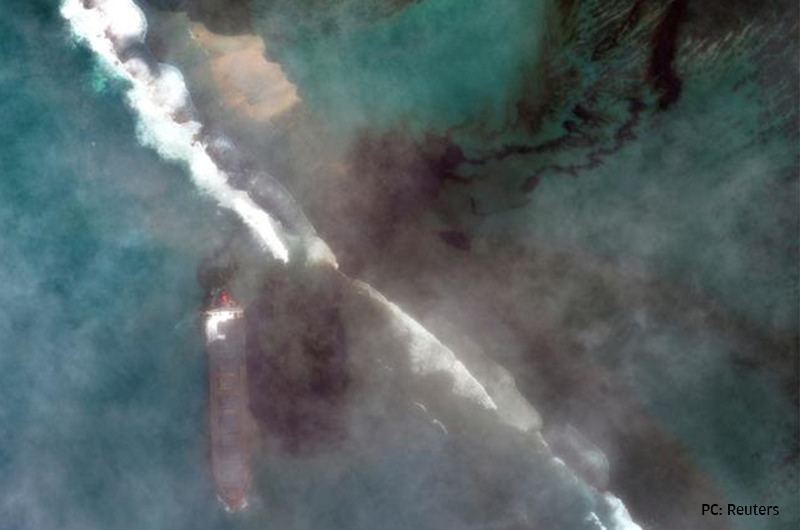On July 25th, a Japanese owned bulk carrier ship MV Wakashio, struck a coral reef at Pointe d’ Esny near the Blue Bay marine park in Mauritius. The oil vessel, belonging to the Nagashiki Shipping Company, was loaded with 3, 800 tonnes of fuel. The ship began from China and was travelling to Brazil. When the tanker ran aground on the globally listed conservation site, it leaked around 900 tonnes of fuel oil into the pristine waters off the island’s south-eastern coast. Pointe d’Esny is a Ramasar site andMauritius’s largest prevailing wetland.
The damaged ship is operated by Mitsui OSK Lines Limited who recently set-up a task force to coordinate with the Japanese and local authorities on the island, in order to contain the spills. The company said that their efforts at controlling the spill were hampered by the raging sea and they will do their “utmost towards resolving the situation quickly.” The marine ecosystem of the island, and potentially that of the entire Indian Ocean region, is under severe danger of choking owing to the rapidly spreading oil cover over the turquoise waters of Mauritius.
The incessant leakage led the Prime Minister, Pravind Kumar Jugnauth, to announce an environmental emergency in the country on August 6 and reach out to France for immediate help. Mr Jugnauth surveyed the disaster-hit site and said, “The sinking of the Wakashio represents a danger for Mauritius. Our country does not have the skills and expertise to refloat stranded ships, so I have requested the help of France.”
The environmental ministry of Mauritius informed that a crack in the tanker’s hull is causing continuous leakage that has caused the oil to spread over other ecologically susceptible regions like the Blue Ray Marine Area, Ile aux Aigrettes Nature Reserve, and Mahebourg Fishing Reserves. The oil sludge also endangers the mangrove forests lined along the island’s eastern shoreline.
The rough waters and bad weather conditions are making the containment and mitigation of the disaster a herculean task for the volunteers. The clean-up crews and local volunteers are struggling to plug the spillage with straw-stuffed cloth sacks, trying to absorb the leaked oil. The Greenpeace Environmental group claimed that this was one of the worst ecological disasters that the island has been faced with till date.
The leak threatens Mauritius’s endemic fauna and flora, it’s painstakingly preserved coral reefs, thriving sanctuaries, mangrove forests and many of the sensitive endangered species on the island. The Greenpeace stated, “Thousands of species around the pristine lagoons of Blue Bay, Pointe d’Esny and Mahebourg are at risk of drowning in a sea of pollution, with dire consequences for Mauritius’s economy, food security and health.”
The extent of damage can be seen through satellite images that show large black patches covering the azure waters, symbolic of an irrevocable damage to years of consistent and successful conservation efforts on the island. Oil from the spills adversely affects the aquatic ecosystem as it exposes the marine life to harsh factors by compromising their adaptability.
Fur-bearing mammals like the sea otters lose their insulating ability in cold water, consequently dying of hypothermia. Dolphins, whales, sea turtles, and shellfish experience physiological damages as they ingest oil that disrupts the functioning of their vital organs and weakens their immune as well as reproductive systems. Corals may not be immediately predisposed to a lethal threat, but over time, oil hampers their multiplication, growth and further development.
Mauritius is known for its unsullied and unique beaches and green tourism making it a world-class destination for nature lovers. Boasting of more than 160 km of beach area, a lagoon garlanded on all four corners by a skirting coral reef, this retreat island thrives on ecotourism. Coral reefs serve as natural backwaters leading to the formation of lagoons along the shore. As they provide breeding ground and shelter for fish and sea fauna, they host a plethora of marine life and are immensely important for the conservation of oceanic biodiversity.
The conservation director at the NGO named Mauritius Wildlife Foundation, Vikash Tatayah, said, “We are starting to see dead fish. We are starting to see animals like crabs covered in oil, we are starting to see seabirds covered in oil, including some which could not be rescued.” The ocean is a major source of not only tourism but also food and employment in the country. The previous year’s tourism industry contributed nearly $1.6 billion to the island’s economy.
The fisheries serve as the main source of employment and income to many and function as an important source of food and exotic sea-cuisine in the country. Thus, the impact on the marine ecology will have severe ramifications for the economic as well as social life of Mauritius.
Apart from the catastrophic ecological aftermath, the oil spills have severely impacted the island’s role as a pitstop for journeying ships in the Indian Ocean region. The affected region served as a nautical terminus allowing ships to pass through the island’s provincial waters.
The former MP and an environmental consultant, Sunil Dowarkasing, expressed helpless remorse over the current scenario and said, “This is no longer a threat to our environment, it is a full-blown ecological disaster that has affected one of the most environmentally important parts of Mauritius, the Mahebourg Lagoon.”
Acknowledging the impending doom, he further exclaimed, “We will never be able to recover from this damage. But what we can do is try to mitigate as much as we can.” Despite the constant efforts of the volunteers and involved authorities to wade off the misphap, the ecologists fear further disintegration of the vessel which bears the potential to cause massive damage to the island’s coastline.









